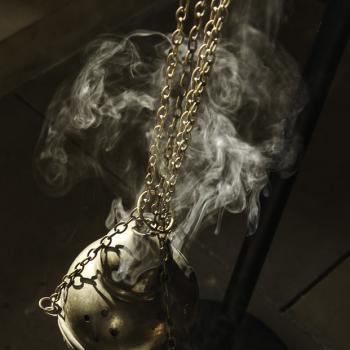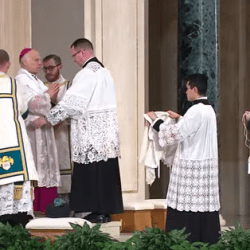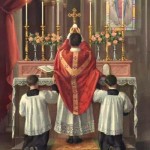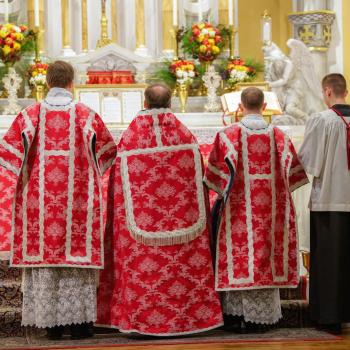In my church tonight, we’re introducing a special liturgy to mark Candlemas, featuring Vespers, the blessing of candles and concluding with Benediction.
So: what exactly is Candlemas? Glad you asked:
Today is a day of purification, renewal, and hope. On this day, exactly 40 days after Christmas, we commemorate Mary’s obedience to the Mosaic law by submitting herself to the Temple for the ritual purification, as commanded in Leviticus:
Speak to the children of Israel, and thou shalt say to them: If a woman having received seed shall bear a man child, she shall be unclean seven days, according to the days of separation of her flowers. And on the eighth day the infant shall be circumcised: But she shall remain three and thirty days in the blood of her purification. She shall touch no holy thing: neither shall she enter into the sanctuary, until the days of her purification, be fulfilled. But if she shall bear a maid child, she shall be unclean two weeks, according to the custom of her monthly courses, and she shall remain in the blood of her purification sixty-six days.
And when the days of her purification are expired, for a son, or for a daughter, she shall bring to the door of the tabernacle of the testimony, a lamb of a year old for a holocaust, and a young pigeon or a turtle for sin, and shall deliver them to the priest: Who shall offer them before the Lord, and shall pray for her, and so she shall be cleansed from the issue of her blood. This is the law for her that beareth a man child or a maid child.
And if her hand find not sufficiency, and she is not able to offer a lamb, she shall take two turtles, or two young pigeons, one for a holocaust, and another for sin: and the priest shall pray for her, and so she shall be cleansed.
Luke 2:22-24
And after the days of her purification, according to the law of Moses, were accomplished, they carried him to Jerusalem, to present him to the Lord: As it is written in the law of the Lord: Every male opening the womb shall be called holy to the Lord: And to offer a sacrifice, according as it is written in the law of the Lord, a pair of turtledoves, or two young pigeons.Also commemorated on this “Feast of Light” (“Lichtmess” in German) or “Feast of the Candles” (“Candelaria” in Spanish, and “La Fête de la Chandeleur” in French) is the prophecy of Holy Simeon — the “just and devout” man of Jerusalem who was inspired by the Holy Ghost to know that he would live to see the “consolation of Jerusalem” — and the encounter with the aged widow, Anna the Prophetess, who lived in the Temple and confessed Christ upon meeting Him.
On this day, there will be a Blessing of the Candles and Procession. The symbolism of the candles is described by Dom Prosper Guéranger, OSB, in his “Liturgical Year”:
The mystery of today’s ceremony has frequently been explained by liturgists, dating from the 7th century. According to Ivo of Chartres, the wax, which is formed from the juice of flowers by the bee, always considered as the emblem of virginity, signifies the virginal flesh of the Divine Infant, who diminished not, either by His conception or His birth, the spotless purity of His Blessed Mother. The same holy bishop would have us see, in the flame of our Candle, a symbol of Jesus who came to enlighten our darkness. St. Anselm, Archbishop of Canterbury, speaking on the same mystery, bids us consider three things in the blessed Candle: the wax, the wick, and the flame. The wax, he says, which is the production of the virginal bee, is the Flesh of our Lord; the wick, which is within, is His Soul; the flame, which burns on top, is His divinity.
We’re hoping to make this an annual tradition in my parish. Meantime, read more about this ancient feast.
And The Anchoress has a great roundup of beautiful thoughts on this “feast of light.”











